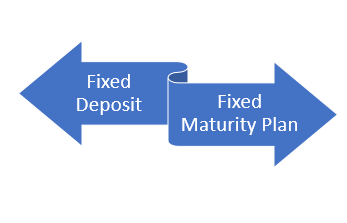We find many Fixed deposit lovers in India. Who are not ready to take any risk and happy with the fixed return. However, in a recent past, it is seen that return on fixed deposits are reducing and it is likely to reduce further. So, what fixed deposit lovers should do? Well, they can explore investment option called as Fixed Maturity Plan (FMP). A Fixed Maturity Plans (FMP) are like FDs only. It can generate fixed returns and has a lock-in period. One can also use Fixed Maturity Plans to save income tax.
What is Fixed Maturity Plan?
A Fixed Maturity Plan is “closed-ended” debt based mutual funds. Closed-ended means it comes with pre-defined lock-in period. This lock-in period varies from 1 month to 3 years.
Fixed Maturity Plan do not invest anything in equity. It invests mainly in debt related investment instruments like –
- Bonds
- Debentures
- Government Securities
- Certificate of Deposits
- Commercial Papers
FMPs are suitable for investors who love FD or in the other words for the investors with low-risk appetite.
- The basic difference is between bank FD and FMP is return from FD is assured. However, in Fixed Maturity Plans (FMPs) returns is not assured. However, FMP generally gives better return compared to Fixed Deposits.
- Another difference is in FMP we have an option to check rating before investing. Credit agencies give rating to FMPs based on performance A, A+, AAA etc. In FD investment is done based on the trustworthiness of bank.
- In FMP one can go through Investment objective and past performance.
Which is better FMP or FDs?
Return –
Let’s take an example of SBI Bank Fixed deposit Interest rate applicable as on today (i.e March 2018)
If you invest in SBI Fixed deposit with following lock-in periods, the interest rate offered by the bank are –
- 1 Year – 6.40%
- 3 Year – 6.50%
This return is pretax return. Tax is applicable on the interest amount based on your tax slab. Now let’s compare the historical return on Fixed Maturity Plans. Historically average return of AAA-rated FMP is in the range of 7.25-7.5%.
Taxability –
The interest amount earned from Fixed deposits is added to the income of investor and taxed as per tax slab. If you are in highest tax bracket it is recommended not to invest in the fixed deposit as post-tax return can’t even beat inflation rate.
In FMPs, there are two options –
- Dividend
- Growth
In dividend option the investor has to face dividend distribution tax, plus applicable tax rate as per slab.
In a growth option two types of taxes are applicable.
- STCG – Applicable if you sell FMP before 3 years of holding time. The rate of STCG is as per ones tax slab.
- LTCG – Applicable if you hold mutual fund for 3 years and above. LTCG is applicable 20% flat, one can take indexation benefit while calculating LTCG.
This means if you are in highest tax bracket it is recommended to invest in FMP compared to FDs.
Also Read – Company Fixed Deposit – 10 Most Important Things to Know before Buying
What are advantages of FMPs?
- Low risk and No interest rate volatility.
- Return is high compared to fixed deposit.
- Tax benefit and indexation benefit.
- Expenses are very limited as FMP invest in debt instruments.
What are Limitations of FMPs?
- Return is not assured in FMP.
- The exit from FMP is slightly difficult as trading volume of FMP is very low.
Points to consider before investing in Fixed Maturity Plan
- Select FMP carefully. Please consider rating given by credit agencies while making a selection. Also check historical return and trustworthiness of fund house.
- Exit from fund is slightly difficult. So, if you have surplus money you can select FMP with long term perspective.
- FMPs are less risky. However, we cannot eliminate risk possibility of default.
I hope you have got answers to all your queries related to Fixed Deposit and FMP.
Do you prefer FMP for investment? Do share your views in the comment section.


